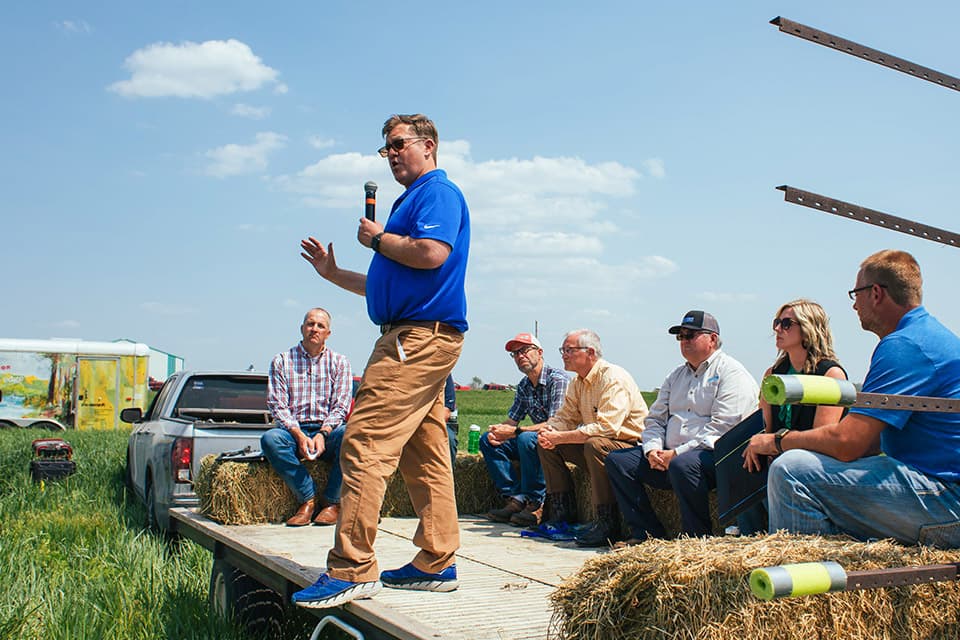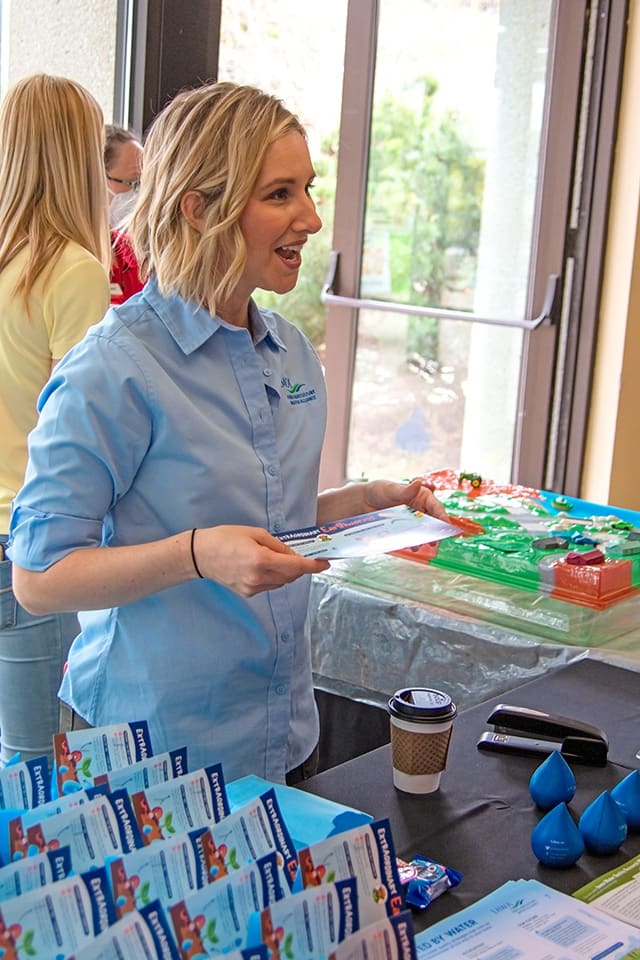A decade of improving water quality
March 8, 2024
Ten years after its founding, the Iowa Agriculture Water Alliance reflects on partnerships and change.
Working together, finding common ground and making significant improvements to Iowa’s waterways is at the heart of the Iowa Agriculture Water Alliance (IAWA).
In 2024, the organization is celebrating its 10th birthday. For a decade, the organization has made significant strides in its mission to increase the pace and scale of farmer-led efforts to improve water quality in Iowa.
A plethora of partners
IAWA Executive Director Sean McMahon says the past 10 years have proven successful because of IAWA’s ability to bring multiple stakeholders together — all of whom are committed to improving water quality.
“It’s really been all about partnerships,” says McMahon. The Iowa Soybean Association (ISA), Iowa Corn and the Iowa Pork Producers Association formed IAWA.
The impetus for creating IAWA was the release of the Iowa Nutrient Reduction Strategy (INRS), which was implemented a year earlier. The strategy is a science- and technology-based approach to assess and reduce nutrients delivered to Iowa waterways and the Gulf of Mexico. It outlines opportunities for reducing nutrients in surface water from both point sources, such as municipal wastewater treatment plants and industrial facilities, and nonpoint sources, including agricultural operations and urban areas, in a scientific, reasonable and cost-effective manner.
The original stakeholders wanted to bring others to the table, generate financial and technical assistance for Iowa farmers and find untapped resources and innovation to improve water quality.
Since then, IAWA has expanded its partnerships to include more than 100 organizations, all aligned around implementing the INRS, McMahon says.
“We’re building bridges between and among the public and private sectors, agriculture and conservation organizations, urban and rural partners, upstream and downstream communities and additional stakeholders from multiple sectors,” he adds.

Working together
Over the past decade, IAWA’s partnerships have connected farmers and landowners with education and cost-share opportunities that have ultimately helped reduce nitrogen and phosphorus loading into the state’s waterways.
“At the beginning, the founding members recognized we’re going to need different partners,” McMahon says.
“That led to the creation of the IAWA Advisory Council and IAWA Business Council, which are leveraged to convene stakeholders and project partners to strategize regarding overcoming barriers to scaling up conservation practices and how to best implement those solutions in public-private partnership to improve Iowa’s water quality.”
IAWA’s Advisory Council is comprised of the leads of the relevant state and federal agencies working on improving water quality like the Iowa Department of Agriculture and Land Stewardship (IDALS), the Iowa Department of Natural Resources, Iowa Natural Resources Conservation Service (USDA-NRCS), the U.S. Geological Survey, Iowa Economic Development Administration, municipalities like the Cities of Des Moines and Cedar Rapids, the Iowa League of Cities, The Nature Conservancy, Ducks Unlimited, Pheasants Forever, every major agricultural commodity group in Iowa, along with the Farm Bureau, Conservation Districts of Iowa, Practical Farmers of Iowa, Iowa State University and more.
There’s also been the support of the IAWA Business Council, which includes agribusinesses and other entities that have a stake in improving water quality including fertilizer companies, farm equipment, seed companies, engineering firms, soil health advisors, independent consulting firms and the ag retail and renewable energy sectors.
At least twice a year, IAWA convenes both councils jointly to participate in discussions and efforts surrounding water quality.
“It’s really a great forum that brings together leaders across different sectors to align them around implementing the Iowa Nutrient Reduction Strategy,” McMahon says.
One specific project IAWA co-leads is the Midwest Ag Water Quality Partnership, a $100 million project that has already improved conservation on more than 4 million acres of land. It’s focused on five priority watersheds: the North Raccoon, the Upper and Middle Cedar Rivers, South Skunk and Lake Red Rock.

“It’s been phenomenally successful at not only improving water quality, but also improving soil health and wildlife habitat,” McMahon says. “It also reduces nitrogen and phosphorus losses in Iowa by 7 million pounds of nitrogen 250,000 pounds of phosphorus, annually.
The project is part of a farm bill program called the Regional Conservation Partnership Program (RCPP), which provides money and assistance to farmers to implement conservation.
Another RCCP project is the Iowa Systems Approach to Conservation Drainage (ISACD) which improves both farm profitability and sustainability on some of the most intensively drained farmland in Iowa. This project is also co-led by IAWA and IDALS.
The ISACD uses in-field practices like cover crops and no-till in tandem with edge-of-field practices like saturated buffers and bioreactors to improve water quality, reduce flood risk and greenhouse gas emissions and protect source water.
The ISACD is a $33 million dollar project with USDA-NRCS providing nearly one-third of the funding.
“Between those two projects, IAWA has brought in a lot of financial assistance to the state of Iowa that otherwise wouldn’t be available to Iowa farmers,” McMahon says.
Iowa Corn Growers CEO Craig Floss agrees.
“IAWA is unparalleled when it comes to improving water quality in Iowa,” Floss says. “In just 10 years, the organization has secured more than $150 million of investment and resources to help farmers, landowners and a myriad of partners in making significant improvements to the state’s watersheds, lakes, ponds, streams and rivers.”
What’s ahead?
IAWA has helped lead the charge in improving Iowa’s water quality, highlighting the importance of conservation practices like cover crops, and increasing buy-in from multiple stakeholders. But there’s much more to be done.
For example, Iowa farmers implement cover crops on roughly 3 million acres of corn and soybean fields — a remarkable figure given that number was estimated at under 50,000 acres in 2010.
“Are we satisfied that we have nearly 3 million acres?” McMahon asks. “No, the ultimate goal is 12-17 million acres with cover crops. That’s roughly 50-70% of Iowa’s row crop acres.
“We know these conservation practices work, we just need to scale them up,” he says.
IAWA, however, is more than a messenger with changing ag practices.
“We’re also the catalyst in creating these projects and recruiting partners that can deliver big impacts through these projects that meaningfully address water quality challenges,” McMahon says.
“There’s a lot more we still need to do to implement the Iowa NRS, particularly when it comes to reducing nitrogen loss, but the progress made in the first decade of implementing the Iowa NRS — has been nothing short of incredible. IAWA and the Iowa Soybean Association, and hundreds of other partners, can be very proud of our accomplishments over the last ten years — what we call the Defining Decade of Iowa’s nutrient reduction strategy.”
McMahon says IAWA wants to reach those who have been reluctant to get involved in conservation practices on their farms or have never had any kind of conservation contract with the NRCS or IDALS.
“We understand there may be some fear of implementing regenerative farming practices, but there are resources and people in place that can reduce risk and even improve bottom lines,” he said. “For example, we’ve raised $1.2 million for conservation agronomists who work at ISA and ag retailers across the state. They can help farmers improve their profitability while improving water quality and more ag retailers are seeing the value in that.”
IAWA wants to continue communication efforts by sharing the good work that has been and continues to be done in the state, while also raising awareness and money for cost-share programming and the expansion of conservation agronomists throughout Iowa.
McMahon says he’s optimistic about the future.
“I’m very confident.” he says, “I believe we will keep accelerating these conservation practices with even more adoption and a greater reduction in nitrogen and phosphorous.”
Learn more about IAWA at iaagwater.org.
Back